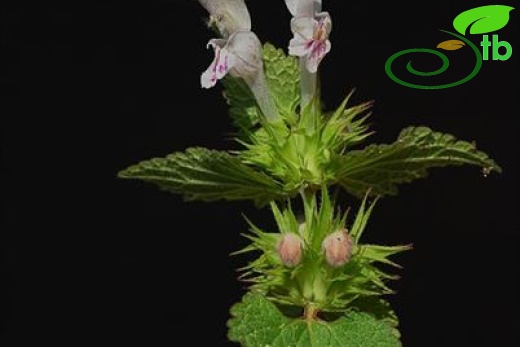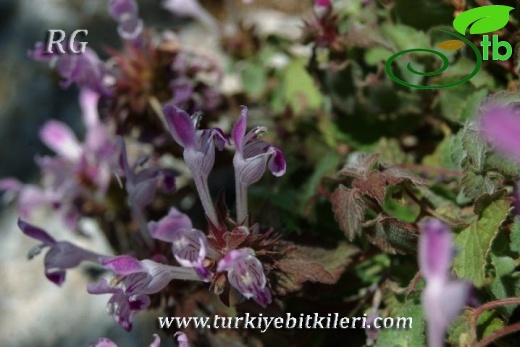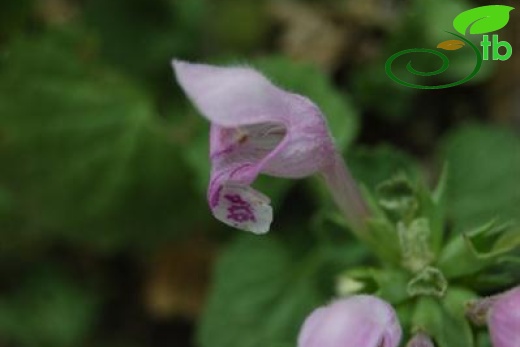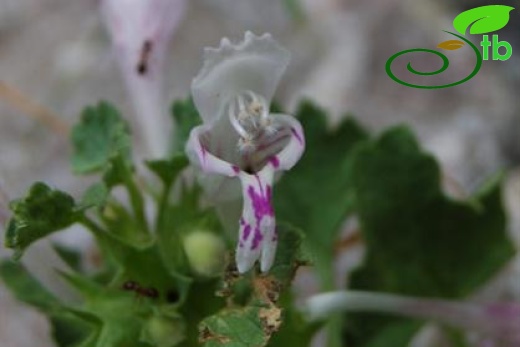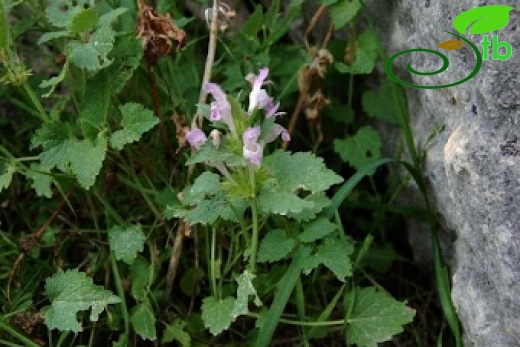Lamium garganicum
Lamium garganicum
Ssp garganicum: Bol balıcak; Ssp striatum: Tel balıcak
Perennial, often sprawling over rocks, sometimes forming mats. Stems 6-45 cm, villous to glabrous. Leaves broadly ovate to reniform, lamina 3-52 x 3-46 mm, crenate or serrate, villous to ± glabrous. Verticillasters 1-5, 4-8-flowered. Bracteoles 3-9 mm. Calyx 8-18 mm, tube glabrous to pubescent or sparingly villous, 5-10 mm; teeth 2-9 mm. Corolla purplish-pink , with purple-striate tube and usually a large purple blotch on lower lip, 22-40 mm; tube straight , without annulus, 14-29 mm; upper lip 6-16 mm, deeply or shortly bifid, emarginate, retuse or ± entire, the lobes themselves sometimes with notched to bifid apices; lower lip 6-20 mm, lateral lobes without or occasionally with a short subulate appendage. Nutlets 2.5-3.5 x 1.3-1.6 mm, blackish-green or brown, usually with a few paler spots.
1. Corolla white with purple veins and bluish-purple blotches at tips of both lips; tube slightly curved; plant mat-forming, with very densely whitish-villous leaves g. subsp. pulchrum
1. Not as above
1. Corolla white with purple veins and bluish-purple blotches at tips of both lips; tube slightly curved; plant mat-forming, with very densely whitish-villous leaves g. subsp. pulchrum
1. Not as above
2. Stems villous
3. Glandular only in inflorescence b. subsp. reniforme
3. Glandular throughout
4. Corolla 34-40 mmf. subsp. lasioclades
3. Glandular only in inflorescence b. subsp. reniforme
3. Glandular throughout
4. Corolla 34-40 mmf. subsp. lasioclades
4. Corolla 2 5-3 2 mm
5. Calyx teeth subequal to tube b. subsp. reniforme
5. Calyx teeth shorter than tube e. subsp. rectum
2. Stems glabrous to densely pubescent
6. Upper lip of corolla deeply bifid, lobes 3-5.5 mm
7. Bracteoles 4-7 mm ...................................................a. subsp. striatum
7. Bracteoles c. 3 mm ..................................................b. subsp. reniforme
6. Upper lip of corolla shortly bifid to subentire, lobes 0-2.5 mm
8. Hairs of stem more than 0.5 mm ..............................b. subsp. reniforme
8. Hairs of stem 0-0.5 mm
9. Median leaves longer than 40 mm
10. Leaf incisions 5-5.5 mm deep ................a. subsp. striatum
10. Leaf incisions 1-4.5 mm deep
11. Erect ..................d. subsp. laevigatum
11. Sprawling or ascending ......b. subsp. reniforme
9. Median leaves less than 40 mm
12. Leaves dentate or acutely crenate c. subsp. nepetifolium
5. Calyx teeth subequal to tube b. subsp. reniforme
5. Calyx teeth shorter than tube e. subsp. rectum
2. Stems glabrous to densely pubescent
6. Upper lip of corolla deeply bifid, lobes 3-5.5 mm
7. Bracteoles 4-7 mm ...................................................a. subsp. striatum
7. Bracteoles c. 3 mm ..................................................b. subsp. reniforme
6. Upper lip of corolla shortly bifid to subentire, lobes 0-2.5 mm
8. Hairs of stem more than 0.5 mm ..............................b. subsp. reniforme
8. Hairs of stem 0-0.5 mm
9. Median leaves longer than 40 mm
10. Leaf incisions 5-5.5 mm deep ................a. subsp. striatum
10. Leaf incisions 1-4.5 mm deep
11. Erect ..................d. subsp. laevigatum
11. Sprawling or ascending ......b. subsp. reniforme
9. Median leaves less than 40 mm
12. Leaves dentate or acutely crenate c. subsp. nepetifolium
12. Leaves obtusely crenate
13. Calyx teeth 3/4-9/10x tube b. subsp. reniforme
13. Calyx teeth 1/2-2/3 X tube
14. Stems pubescent, hairs 0.2-0.3 mm a. subsp. striatum
14. Stems ± glabrous or puberulent, hairs usually less than 0.1 mm, never exceeding 0.2 mm
13. Calyx teeth 3/4-9/10x tube b. subsp. reniforme
13. Calyx teeth 1/2-2/3 X tube
14. Stems pubescent, hairs 0.2-0.3 mm a. subsp. striatum
14. Stems ± glabrous or puberulent, hairs usually less than 0.1 mm, never exceeding 0.2 mm



